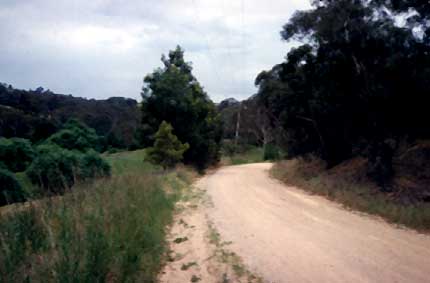Notes on a Rare Broadside
© John Low
On the 4th September 1860 Phillip Skillicorn, a butcher from the central west of NSW, rode his horse from Bathurst, over the Blue Mountains, to Sydney in twenty hours. The ride, organised in response to a wager with a local innkeeper, aroused considerable popular interest.
In mid-nineteenth century Australia, bush folk took great pride in the tough, fast horses they were breeding and many an argument developed over just how far, and how fast, a horse could race.
Sometimes matches of stamina were conducted under official race club conditions, like the 10-mile race organised for the third day of the annual Wagga Wagga race meeting in November 1868. However, such races generally took a heavy toll on the horses involved and the racing clubs tended to stick to more humane, shorter distances.
Individuals, however, often showed no such scruples. Seven years before Skillicorn, a man named Mossman raced his horse for a wager from Sydney to Maitland (140 miles) in 20 hours, his horse dying soon after completing the journey. Those involved in Skillicorn’s ride did not escape censure. The Sydney Morning Herald was severely critical of the whole affair and expressed the hope that such an event would not be repeated.
THE BROADSIDE AND THE POET
Around the turn of the century a poem titled Ride From Bathurst to Sydney, in Twenty Hours, 1857, By an Eye-Witness appeared on a small broadside (15.5 x 21.5cms), along with two other poems, The First Free Selection of Land in New South Wales (also attributed to “Eye Witness”) and First Waggon Over The Mountains, 1856 (by James Harvey). Though attributed to an “eye witness”, the poem contains numerous errors of fact and chronology (including even the year the ride took place) and was clearly written well after the event.
It is generally agreed that “Eye Witness” is James Harvey, the author of one of the other poems on the broadside. Both the folklorist John Meredith, who discussed the broadside in Australian Tradition (No.17 September 1968), and the journalist and historian William Freame, who published The Ride From Bathurst To Sydney in The Nepean Times, 2 December 1916, attribute authorship to him. Not much is known about James Harvey other than that he claimed to have been the first to drive a wagon over the Blue Mountains, a claim supported by James T. Ryan in his Reminiscences of Australia, first published in 1894 and quoted on the broadside.
In literary terms the verse hardly rates above the level of doggerel. However, as John Meredith points out in his Australian Tradition article, despite Harvey’s lack of talent as a ballad writer, some of his enthusiasm for the event and his excitement as an eye witness is captured, giving the piece a dramatic quality that lifts it beyond the forgettable. Apart from any literary importance, the poem is certainly of value historically for the description it gives of travelling the Western Road between Bathurst and Sydney in the mid-nineteenth century.

THE MAIN CHARACTERS
Phillip Skillicorn (sometimes spelt with an “e”) was born at Kirk Michael on the Isle of Man in 1819. In 1837 he married Ellen Corkan and, accompanied by his sister Rebecca, the couple arrived in Sydney as Bounty Immigrants on board the “Clyde” in 1840. A son Thomas was born in 1847 and a daughter Ann Jane in 1850, at which time Skillicorn was working as a butcher in Windsor on the Hawkesbury River. A second son Phillip was born in 1853 after the family had moved to Sofala and, by the time he responded to the challenge of Job Manning, Skillicorn had transferred his butchering business to Bathurst. His shop was located in George Street, between Howick and Russell Streets.
According to James MacAlister, Skillicorn was “amongst the brave soldiers of fortune who visited the [gold] rush” in Forbes in 1862-3 and, in May the following year, “young Mr.Skillicorn of Bathurst” (possibly son Thomas) narrowly escaped a confrontation with Ben Hall at the Bang Bang Hotel while on his way from Cowra to Lambing Flat with five racehorses. [Penzig, p.91].
By the late 1860s, Skillicorn had moved back to Sydney. “Old Chum”, in the Sydney Truth of 26 March 1916, states that he had a butchery at Brickfield Hill on the corner of Wilmot and George Streets in 1872, while The Sands Directory for 1880 lists a Philip (sic) Skillicorn, butcher, Regent Street Redfern (though this could be his son).
The move to Sydney appears to have heralded also a growing problem with alcohol and a decline in his personal life. The trajectory of that decline is starkly and tragically charted in the Darlinghurst Gaol Entrance Books. From 1869 and throughout the next decade there are numerous entries recording Skillicorn’s arrest and sentencing to short periods of imprisonment for drunkenness. The NSW Index To Births, Deaths & Marriages records his death in 1881 and the last entry in the Gaol Entrance Book states that he “died in Gaol Hospital 17th January”. He was within a few weeks of his 62nd birthday. His wife Ellen died in 1896 at St. Leonards and is buried in the Church of England section of the Gore Hill Cemetery.
Job Manning, the man who accepted Skillicorn’s challenge and laid the wager with him, was the owner and licensee of The Rose & Crown in Bathurst. This hotel, built by Manning in 1853, was also in George Street, just down from Skillicorn’s butcher shop, in the block between Durham and Howick Streets.While the poem makes no comment on the settling of the bet, a number of accounts of the ride cast Manning in a less than favourable light. Duke Tritton, recounting the story as told to him by an old Bathurst-born coach driver, Dick Knight, says:
“He [Skillicorn] completed the ride with an hour to spare, but the other chaps, who had followed him, with several changes of horses, refused to pay because a few times he had dismounted for some purpose or other, and before remounting he had led his horse a few yards. Therefore, they argued, he had not ridden the horse all the way to Sydney. ‘A dirty point’, Dick remarked, ‘They saved their money, but were the most unpopular men in Bathurst for many years’.” (Tritton, p.97)
The two Bathurst historians, Greaves and Barker, both mention Manning’s failure to pay up. Greaves states that this was “because Skillicorn dismounted at one end of a trough at Wentworth Falls and mounted at the other” (p.62), while Barker says it was “because Skillicorn had dismounted and led his horse over a bad place on the road” (p.194). Both go further than Dick Knight and claim that feeling ran so high against Manning in Bathurst that he was forced to leave the town. If this latter point is correct, it appears that Manning’s exile was not permanent, for he held the licence for The Rose & Crown throughout the period 1853-79 (W.H. Tighe p.4) and died in Bathurst in 1880 (Index BD&M).
Skillicorn’s horse, Poor Man’s Friend, the real hero of the story, was a brown or bay gelding that stood 14 hands and 2 inches high and had a long white star on its forehead and a Q-shaped brand near its shoulder. Bell’s Life (8 Sept.1860, p.3) considered it “a remarkably game-looking wiry nag … though rather small to carry Mr. Skillicorn’s weight over such a journey.” The Bathurst Free Press (15 Sept.1860) reported that:
“To the casual observer he presents nothing unusual in appearance. On close inspection, however, his superior points become manifest in his remarkably fine quarters, and a set of stout clean legs, while his well-proportioned frame stamps him as an animal up to almost any weight or distance. Under the careful attendance of the grooms he is rapidly improving from the effects of the journey, and beyond a swelling of the fetlocks, and a stiffness in the muscles of his legs, there is nothing which would indicate that he so recently, in bad weather, and on a worse road, carried a 12-stone man, in less than twenty hours, from Bathurst to Sydney. The feat is more remarkable as the horse underwent no training, and was in anything but tip-top condition when he started.”
The Poor Man’s Friend aroused considerable interest and drew a large crowd to Charles Martyn’s horse and carriage ‘Bazaar’, 246 Pitt Street, Sydney, where it was stabled after the race. While many people thought it had finished in better shape than its owner, its marathon performance was not approved of uniformly. On the following day The Sydney Morning Herald, for example, took a very critical view. Such a race, it said, was “one which for the credit of humanity it is to be hoped will not be repeated. The cruelty which such a performance involves, in our opinion more than counterbalances any interest which it may otherwise create; and it is but sorry sport, after all, to overtax the powers of a noble horse to such an extraordinary degree.” The paper went on to compare the sportsmen of Bathurst, where the event was “treated very lightly” and “spoken of as though it were an ordinary sporting event of everyday occurrence”, with the sportsmen of the metropolis who “for the most part strongly condemned the whole thing from beginning to end.”
© John Low
 John has been a teacher and a librarian and is a published author and poet. He was Local Studies Librarian at the Blue Mountains City Library from 1982 until his retirement in 2007. In his ‘senior’ years he continues to spend his time exploring the Blue Mountains and pursuing an antiquarian interest in the curiosities of local history.
John has been a teacher and a librarian and is a published author and poet. He was Local Studies Librarian at the Blue Mountains City Library from 1982 until his retirement in 2007. In his ‘senior’ years he continues to spend his time exploring the Blue Mountains and pursuing an antiquarian interest in the curiosities of local history.
CONTACT: john@simplyaustralia.net

